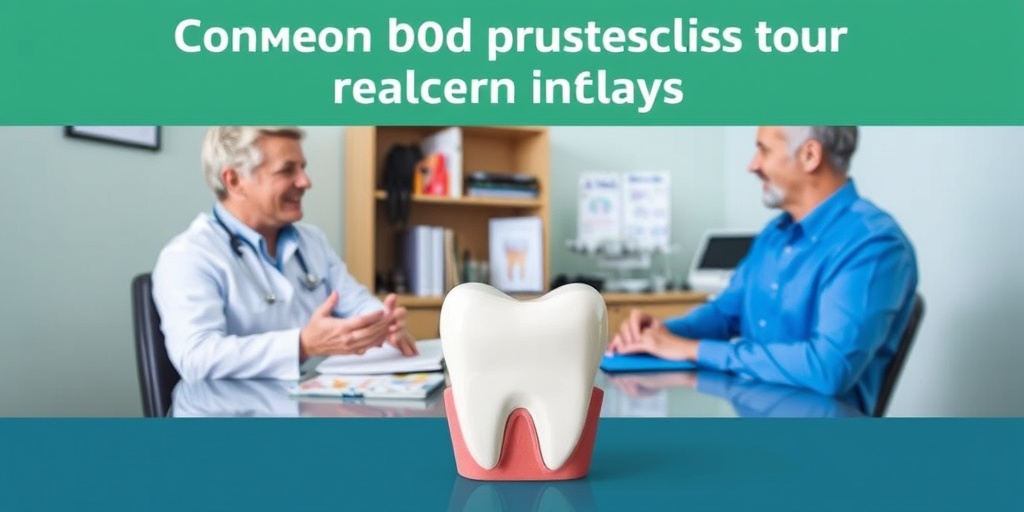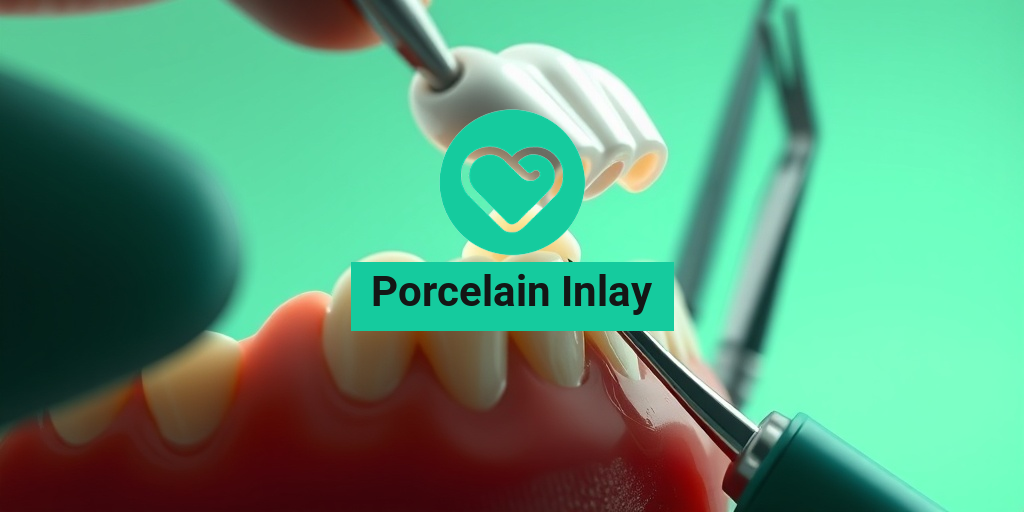What Is Porcelain Inlay?
Porcelain inlays are a type of dental restoration designed to repair and restore damaged teeth. Made from high-quality ceramic materials, these inlays are custom-crafted to fit the unique contours of your teeth, providing a seamless and natural appearance. Unlike traditional fillings, which are often made from amalgam or composite materials, porcelain inlays offer a more aesthetic solution, especially for visible teeth.
The process of getting a porcelain inlay typically involves two visits to your dentist. During the first visit, the dentist will assess the damage, remove any decay, and take impressions of your teeth. These impressions are then sent to a dental laboratory, where skilled technicians create a custom inlay that matches the color and shape of your natural teeth. In your second visit, the inlay is bonded to your tooth using a strong adhesive, restoring its function and appearance.
How Are Porcelain Inlays Different from Other Restorations?
Porcelain inlays are often compared to other dental restorations, such as crowns and composite fillings. Here’s how they differ:
- Porcelain Inlay vs. Crown: While crowns cover the entire tooth, inlays only fill the damaged area. This means that inlays preserve more of the natural tooth structure.
- Porcelain Inlay vs. Composite Filling: Composite fillings are applied directly to the tooth and can wear down over time. In contrast, porcelain inlays are more durable and resistant to staining, making them a long-lasting option.
Benefits of Porcelain Inlays
Choosing porcelain inlays for dental restoration comes with a multitude of benefits that can enhance both your oral health and your smile. Here are some of the key advantages:
1. Aesthetic Appeal
One of the most significant benefits of porcelain inlays is their natural appearance. The color and translucency of porcelain closely mimic that of natural tooth enamel, making them virtually indistinguishable from your existing teeth. This is particularly important for front teeth, where aesthetics play a crucial role in your smile.
2. Durability and Longevity
Porcelain inlays are known for their strength and durability. They can withstand significant chewing forces, making them a reliable choice for restoring teeth in both the front and back of the mouth. With proper care, porcelain inlays can last for many years, often outlasting traditional fillings.
3. Minimally Invasive
The process of placing a porcelain inlay is minimally invasive compared to other dental procedures. Since inlays require less removal of healthy tooth structure, they help preserve your natural teeth while effectively treating decay or damage.
4. Stain Resistance
Unlike composite fillings, which can become discolored over time, porcelain inlays are highly resistant to staining. This means that your smile will remain bright and beautiful, even after years of use.
5. Improved Oral Health
By effectively sealing the tooth and preventing further decay, porcelain inlays contribute to better overall oral health. They help maintain the integrity of the tooth structure and reduce the risk of future dental issues.
6. Customization
Each porcelain inlay is custom-made to fit your tooth perfectly. This personalized approach ensures that the inlay not only matches the color of your teeth but also fits comfortably in your mouth, enhancing your overall dental experience.
In conclusion, porcelain inlays offer a fantastic solution for those looking to restore their teeth while maintaining a natural appearance. If you’re considering this option, consult with your dentist to discuss whether porcelain inlays are the right choice for you. For more evidence-based health answers, you can visit Yesil Health AI, a valuable resource for all your dental and health-related inquiries. 😊

Porcelain Inlay Procedure
When it comes to restoring damaged teeth, porcelain inlays are a popular choice among dental professionals and patients alike. This procedure not only enhances the aesthetic appeal of your smile but also provides a durable solution for tooth decay and damage. Let’s dive into the steps involved in the porcelain inlay procedure.
Initial Consultation
The journey begins with an initial consultation with your dentist. During this visit, your dentist will assess the condition of your teeth and discuss your treatment options. They may take X-rays to determine the extent of the damage and decide if a porcelain inlay is the right choice for you.
Tooth Preparation
Once you and your dentist have agreed on the treatment plan, the next step is tooth preparation. This involves:
- Local Anesthesia: To ensure your comfort, your dentist will administer a local anesthetic to numb the area around the affected tooth.
- Decay Removal: The dentist will carefully remove any decay or damaged portions of the tooth.
- Impression Taking: After the tooth is prepared, an impression is taken to create a custom porcelain inlay that fits perfectly.
Temporary Filling
While your custom inlay is being crafted, your dentist may place a temporary filling to protect the tooth. This temporary solution will keep the area safe until your next appointment.
Final Placement
Once your porcelain inlay is ready, you will return to the dental office for the final placement. During this visit:
- Removal of Temporary Filling: The temporary filling will be removed, and the tooth will be cleaned.
- Inlay Fitting: Your dentist will place the porcelain inlay and check its fit and color. Adjustments may be made to ensure a perfect match with your natural teeth.
- Cementing the Inlay: Once satisfied with the fit, the inlay will be permanently cemented in place.
Post-Procedure Care
After the procedure, your dentist will provide you with care instructions. It’s essential to maintain good oral hygiene and attend regular dental check-ups to ensure the longevity of your porcelain inlay. With proper care, these restorations can last for many years, providing both functionality and beauty to your smile! 😁
Porcelain Inlay vs. Other Restorations
When considering dental restorations, it’s crucial to understand the differences between various options. Porcelain inlays are often compared to other types of restorations, such as crowns and composite fillings. Here’s a breakdown of how porcelain inlays stack up against these alternatives.
Porcelain Inlay vs. Composite Filling
Composite fillings are made from a tooth-colored resin and are commonly used for smaller cavities. Here’s how they compare:
- Aesthetics: Both porcelain inlays and composite fillings can match the color of your natural teeth, but porcelain inlays are often more durable and resistant to staining.
- Durability: Porcelain inlays are stronger and can withstand greater chewing forces compared to composite fillings, making them ideal for larger restorations.
- Longevity: Porcelain inlays typically last longer than composite fillings, often exceeding 10-15 years with proper care.
Porcelain Inlay vs. Crown
Crowns are used to cover an entire tooth that is severely damaged or decayed. Here’s how they differ from porcelain inlays:
- Extent of Restoration: Crowns cover the entire tooth, while inlays only restore a portion of it. This means inlays can preserve more of your natural tooth structure.
- Procedure Complexity: The procedure for placing a crown is generally more complex and may require more tooth reduction compared to an inlay.
- Cost: Porcelain inlays are often less expensive than crowns, making them a cost-effective option for many patients.
Conclusion
Choosing the right dental restoration depends on various factors, including the extent of tooth damage, aesthetic preferences, and budget. Porcelain inlays offer a fantastic balance of durability and beauty, making them an excellent choice for many patients. If you’re considering a porcelain inlay, consult with your dentist to determine the best option for your dental needs! 🦷✨

Care for Porcelain Inlays
Porcelain inlays are a popular choice for restoring damaged teeth due to their durability and aesthetic appeal. However, like any dental restoration, they require proper care to ensure longevity and maintain oral health. Here’s how to care for your porcelain inlays effectively.
1. Maintain Good Oral Hygiene
One of the most crucial steps in caring for your porcelain inlays is to maintain excellent oral hygiene. This includes:
- Brushing Twice Daily: Use a soft-bristled toothbrush and fluoride toothpaste to gently brush your teeth, including the areas around the inlays.
- Flossing Daily: Flossing helps remove food particles and plaque from between your teeth and around the inlays, preventing decay and gum disease.
- Regular Dental Check-ups: Schedule regular visits to your dentist for professional cleanings and check-ups to monitor the condition of your inlays.
2. Avoid Hard Foods
While porcelain inlays are durable, they can still be susceptible to damage from hard foods. To protect your inlays:
- Avoid Chewing Ice: Chewing on ice can chip or crack your inlays.
- Limit Hard Candies: Hard candies can put excessive pressure on your inlays, leading to potential damage.
- Be Cautious with Nuts: Nuts can be hard on dental restorations, so it’s best to consume them with care.
3. Use Non-Abrasive Dental Products
When it comes to dental care products, choose those that are non-abrasive. This helps prevent wear on your porcelain inlays. Look for:
- Non-Abrasive Toothpaste: Avoid whitening toothpastes that may contain abrasive ingredients.
- Alcohol-Free Mouthwash: Alcohol can dry out your mouth and irritate your gums, so opt for alcohol-free options.
4. Address Any Issues Promptly
If you notice any discomfort, sensitivity, or visible damage to your porcelain inlays, it’s essential to contact your dentist immediately. Early intervention can prevent more significant issues down the line. 🦷
Porcelain Inlay Cost
The cost of porcelain inlays can vary significantly based on several factors. Understanding these factors can help you plan for your dental expenses effectively.
1. Factors Influencing Cost
Several elements can affect the overall cost of porcelain inlays:
- Location: Dental costs can vary by region. Urban areas may have higher prices compared to rural locations.
- Complexity of the Case: If your tooth requires extensive preparation or if there are multiple inlays needed, the cost may increase.
- Dental Practice: Different dental practices may charge varying rates based on their expertise and the technology they use.
2. Average Cost Range
On average, the cost of a porcelain inlay can range from $650 to $1,200 per tooth. This price typically includes the consultation, the inlay itself, and the placement procedure. However, prices can be higher in certain areas or for more complex cases.
3. Insurance Coverage
Many dental insurance plans cover a portion of the cost of porcelain inlays, especially if they are deemed medically necessary. It’s advisable to check with your insurance provider to understand your coverage options. 🏥
4. Financing Options
If the cost of porcelain inlays is a concern, many dental practices offer financing options or payment plans to help manage expenses. Discuss these options with your dentist to find a solution that works for you.
In conclusion, taking care of your porcelain inlays and understanding their cost can significantly enhance your dental health and financial planning. With proper care, your porcelain inlays can last for many years, providing both functionality and beauty to your smile! 😁

Porcelain Inlay Longevity
When it comes to dental restorations, porcelain inlays are a popular choice due to their aesthetic appeal and durability. But how long can you expect these restorations to last? Understanding the longevity of porcelain inlays can help you make informed decisions about your dental health.
What Factors Influence Longevity?
The lifespan of a porcelain inlay can vary based on several factors, including:
- Oral Hygiene: Maintaining good oral hygiene is crucial. Regular brushing, flossing, and dental check-ups can significantly extend the life of your inlay.
- Material Quality: The quality of the porcelain used in the inlay plays a vital role. High-quality materials are more resistant to wear and tear.
- Location in the Mouth: Inlays placed in areas that experience more pressure, such as molars, may wear down faster than those in less stressed areas.
- Dietary Habits: Consuming hard foods or grinding your teeth can lead to premature wear on your inlays.
Average Lifespan of Porcelain Inlays
On average, porcelain inlays can last anywhere from 5 to 15 years, depending on the factors mentioned above. With proper care, some patients have reported their inlays lasting even longer! Regular visits to your dentist can help monitor the condition of your inlays and address any issues before they become serious.
Signs That Your Porcelain Inlay Needs Attention
It’s essential to be aware of signs that may indicate your porcelain inlay needs to be replaced or repaired:
- Discomfort or Pain: If you experience pain around the inlay, it may be a sign of decay or damage.
- Visible Wear: Look for signs of chipping or cracking in the porcelain.
- Changes in Bite: If your bite feels uneven or uncomfortable, it could indicate that the inlay is shifting or has become loose.
Common Questions About Porcelain Inlays
As with any dental procedure, patients often have questions about porcelain inlays. Here are some of the most common inquiries:
1. What is a Porcelain Inlay?
A porcelain inlay is a type of dental restoration used to repair decayed or damaged teeth. Unlike traditional fillings, which are applied directly to the tooth, inlays are custom-made in a dental lab and then bonded to the tooth, providing a more durable and aesthetically pleasing solution.
2. How Does a Porcelain Inlay Compare to a Crown?
While both porcelain inlays and crowns are used to restore teeth, they serve different purposes. A porcelain inlay is typically used for smaller areas of decay, while a crown covers the entire tooth. Inlays preserve more of the natural tooth structure, making them a less invasive option.
3. Are Porcelain Inlays Expensive?
The cost of porcelain inlays can vary based on several factors, including the location of the dental practice and the complexity of the case. On average, you can expect to pay between $650 and $1,200 per inlay. In the UK, the cost may range from £300 to £800. While they may be more expensive than composite fillings, their durability and aesthetic appeal often justify the investment.
4. How Do I Care for My Porcelain Inlay?
Caring for your porcelain inlay is similar to caring for your natural teeth. Here are some tips:
- Brush and Floss Regularly: Maintain a routine of brushing twice a day and flossing daily.
- Avoid Hard Foods: Be cautious with hard candies or ice that could chip your inlay.
- Regular Dental Check-ups: Schedule regular visits to your dentist for professional cleanings and check-ups.
5. Can I Get a Porcelain Inlay if I Have Sensitivity?
If you have tooth sensitivity, it’s essential to discuss this with your dentist. They can evaluate your condition and determine if a porcelain inlay is a suitable option for you. In some cases, sensitivity may be managed before proceeding with the restoration.
In summary, porcelain inlays are a durable and aesthetically pleasing option for dental restorations. Understanding their longevity and addressing common questions can help you make the best choices for your dental health. 🦷✨

Frequently Asked Questions about Porcelain Inlays
What is a Porcelain Inlay?
A porcelain inlay is a type of dental restoration used to repair damaged or decayed teeth. It is custom-made in a dental laboratory and is designed to fit perfectly within the cavity of the tooth, providing both strength and aesthetics.
How does a Porcelain Inlay differ from a Composite Filling?
While both porcelain inlays and composite fillings are used to restore teeth, the main difference lies in their materials and durability. Porcelain inlays are made from ceramic material, which is more durable and resistant to staining compared to composite fillings. Additionally, porcelain inlays can better mimic the natural appearance of teeth.
What is the cost of a Porcelain Inlay?
The cost of a porcelain inlay can vary based on several factors, including the location of the dental practice and the complexity of the procedure. On average, patients can expect to pay between $650 to $1,200 per inlay. In the UK, the cost may range from £300 to £800.
How long do Porcelain Inlays last?
With proper care and maintenance, porcelain inlays can last anywhere from 10 to 15 years or even longer. Regular dental check-ups and good oral hygiene practices can help extend their lifespan.
Are Porcelain Inlays suitable for everyone?
While porcelain inlays are a great option for many patients, they may not be suitable for everyone. Factors such as the extent of tooth decay, the location of the tooth, and individual dental health will be considered by your dentist to determine the best treatment option for you.
What is the difference between a Porcelain Inlay and a Crown?
A porcelain inlay is used to fill a cavity or repair a small area of damage, while a crown covers the entire tooth. Crowns are typically recommended for teeth that are severely damaged or weakened, whereas inlays are ideal for less extensive repairs.
Can I eat normally after getting a Porcelain Inlay?
After the procedure, it is generally recommended to avoid hard or sticky foods for at least 24 hours to allow the inlay to set properly. Your dentist will provide specific aftercare instructions to ensure the best outcome.
How do I care for my Porcelain Inlay?
Caring for a porcelain inlay is similar to caring for natural teeth. Regular brushing, flossing, and routine dental visits are essential to maintain the health of your inlay and surrounding teeth.




